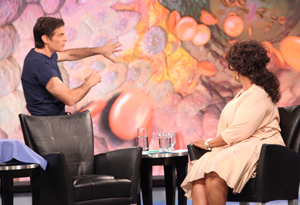Diabetes: America's Silent Killer

PAGE 4
Dr. Oz says one of the major misconceptions about diabetes is that it's only a sugar problem. The truth is, you do need some sugar.
Your body uses sugar (also called simple carbohydrates) to help the brain think and keep muscles moving. When you eat, your food goes through a digestive process that separates sugar and glucose from the rest. That sugar makes its way into your bloodstream. In a healthy body, the pancreas releases insulin, a hormone which helps funnel sugar from the bloodstream to tissues that need it.
Watch Dr. Oz's animation of what diabetes does to your body.
However, too much sugar can be a serious problem. "We store it in our belly," Dr. Oz says. "But that belly fat, the omentum, gets ponderously large. And as it does that, it poisons the insulin so it no longer can work and the sugar cannot get out of the bloodstream."
This causes issues for the heart. "The blood vessels are very delicate," he says. "The sugar is like pieces of glass shard scraping at it."
These shards leave small holes on the inside of the artery. "Our body scars in an attempt to heal it. It's a fragile repair," Dr. Oz says. "It breaks; it ruptures. Now you have an open surface that's sore."
As a scab forms over that sore, Dr. Oz says it gets larger and hardens the arteries—leading to a heart attack. "A diabetic will most likely die from a heart attack," he says.
See how diabetes can affect your heart
Your body uses sugar (also called simple carbohydrates) to help the brain think and keep muscles moving. When you eat, your food goes through a digestive process that separates sugar and glucose from the rest. That sugar makes its way into your bloodstream. In a healthy body, the pancreas releases insulin, a hormone which helps funnel sugar from the bloodstream to tissues that need it.
Watch Dr. Oz's animation of what diabetes does to your body.
However, too much sugar can be a serious problem. "We store it in our belly," Dr. Oz says. "But that belly fat, the omentum, gets ponderously large. And as it does that, it poisons the insulin so it no longer can work and the sugar cannot get out of the bloodstream."
This causes issues for the heart. "The blood vessels are very delicate," he says. "The sugar is like pieces of glass shard scraping at it."
These shards leave small holes on the inside of the artery. "Our body scars in an attempt to heal it. It's a fragile repair," Dr. Oz says. "It breaks; it ruptures. Now you have an open surface that's sore."
As a scab forms over that sore, Dr. Oz says it gets larger and hardens the arteries—leading to a heart attack. "A diabetic will most likely die from a heart attack," he says.
See how diabetes can affect your heart



